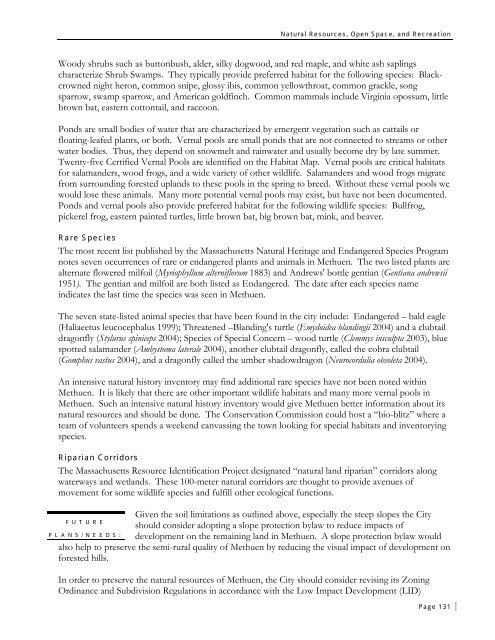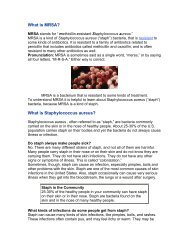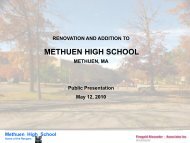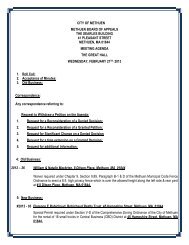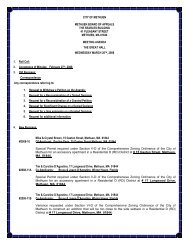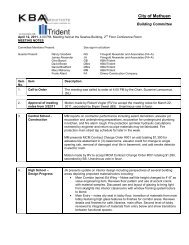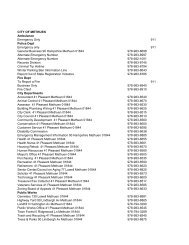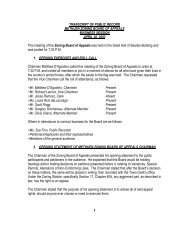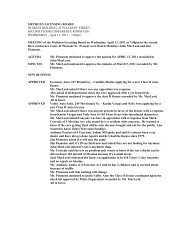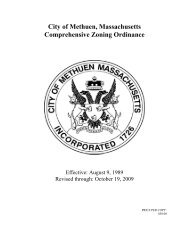City of Methuen Master Plan
City of Methuen Master Plan
City of Methuen Master Plan
Create successful ePaper yourself
Turn your PDF publications into a flip-book with our unique Google optimized e-Paper software.
Natural Resources, Open Space, and Recreation<br />
Woody shrubs such as buttonbush, alder, silky dogwood, and red maple, and white ash saplings<br />
characterize Shrub Swamps. They typically provide preferred habitat for the following species: Blackcrowned<br />
night heron, common snipe, glossy ibis, common yellowthroat, common grackle, song<br />
sparrow, swamp sparrow, and American goldfinch. Common mammals include Virginia opossum, little<br />
brown bat, eastern cottontail, and raccoon.<br />
Ponds are small bodies <strong>of</strong> water that are characterized by emergent vegetation such as cattails or<br />
floating-leafed plants, or both. Vernal pools are small ponds that are not connected to streams or other<br />
water bodies. Thus, they depend on snowmelt and rainwater and usually become dry by late summer.<br />
Twenty-five Certified Vernal Pools are identified on the Habitat Map. Vernal pools are critical habitats<br />
for salamanders, wood frogs, and a wide variety <strong>of</strong> other wildlife. Salamanders and wood frogs migrate<br />
from surrounding forested uplands to these pools in the spring to breed. Without these vernal pools we<br />
would lose these animals. Many more potential vernal pools may exist, but have not been documented.<br />
Ponds and vernal pools also provide preferred habitat for the following wildlife species: Bullfrog,<br />
pickerel frog, eastern painted turtles, little brown bat, big brown bat, mink, and beaver.<br />
Rare Species<br />
The most recent list published by the Massachusetts Natural Heritage and Endangered Species Program<br />
notes seven occurrences <strong>of</strong> rare or endangered plants and animals in <strong>Methuen</strong>. The two listed plants are<br />
alternate flowered milfoil (Myriophyllum alterniflorum 1883) and Andrews' bottle gentian (Gentiana andrewsii<br />
1951). The gentian and milfoil are both listed as Endangered. The date after each species name<br />
indicates the last time the species was seen in <strong>Methuen</strong>.<br />
The seven state-listed animal species that have been found in the city include: Endangered – bald eagle<br />
(Haliaeetus leucocephalus 1999); Threatened –Blanding's turtle (Emydoidea blandingii 2004) and a clubtail<br />
dragonfly (Stylurus spiniceps 2004); Species <strong>of</strong> Special Concern – wood turtle (Clemmys insculpta 2003), blue<br />
spotted salamander (Ambystoma laterale 2004), another clubtail dragonfly, called the cobra clubtail<br />
(Gomphus vastus 2004), and a dragonfly called the umber shadowdragon (Neurocordulia obsoleta 2004).<br />
An intensive natural history inventory may find additional rare species have not been noted within<br />
<strong>Methuen</strong>. It is likely that there are other important wildlife habitats and many more vernal pools in<br />
<strong>Methuen</strong>. Such an intensive natural history inventory would give <strong>Methuen</strong> better information about its<br />
natural resources and should be done. The Conservation Commission could host a “bio-blitz” where a<br />
team <strong>of</strong> volunteers spends a weekend canvassing the town looking for special habitats and inventorying<br />
species.<br />
Riparian Corridors<br />
The Massachusetts Resource Identification Project designated “natural land riparian” corridors along<br />
waterways and wetlands. These 100-meter natural corridors are thought to provide avenues <strong>of</strong><br />
movement for some wildlife species and fulfill other ecological functions.<br />
Given the soil limitations as outlined above, especially the steep slopes the <strong>City</strong><br />
FUTURE<br />
should consider adopting a slope protection bylaw to reduce impacts <strong>of</strong><br />
development on the remaining land in <strong>Methuen</strong>. A slope protection bylaw would<br />
also help to preserve the semi-rural quality <strong>of</strong> <strong>Methuen</strong> by reducing the visual impact <strong>of</strong> development on<br />
forested hills.<br />
PLANS/NEEDS:<br />
In order to preserve the natural resources <strong>of</strong> <strong>Methuen</strong>, the <strong>City</strong> should consider revising its Zoning<br />
Ordinance and Subdivision Regulations in accordance with the Low Impact Development (LID)<br />
Page 131


